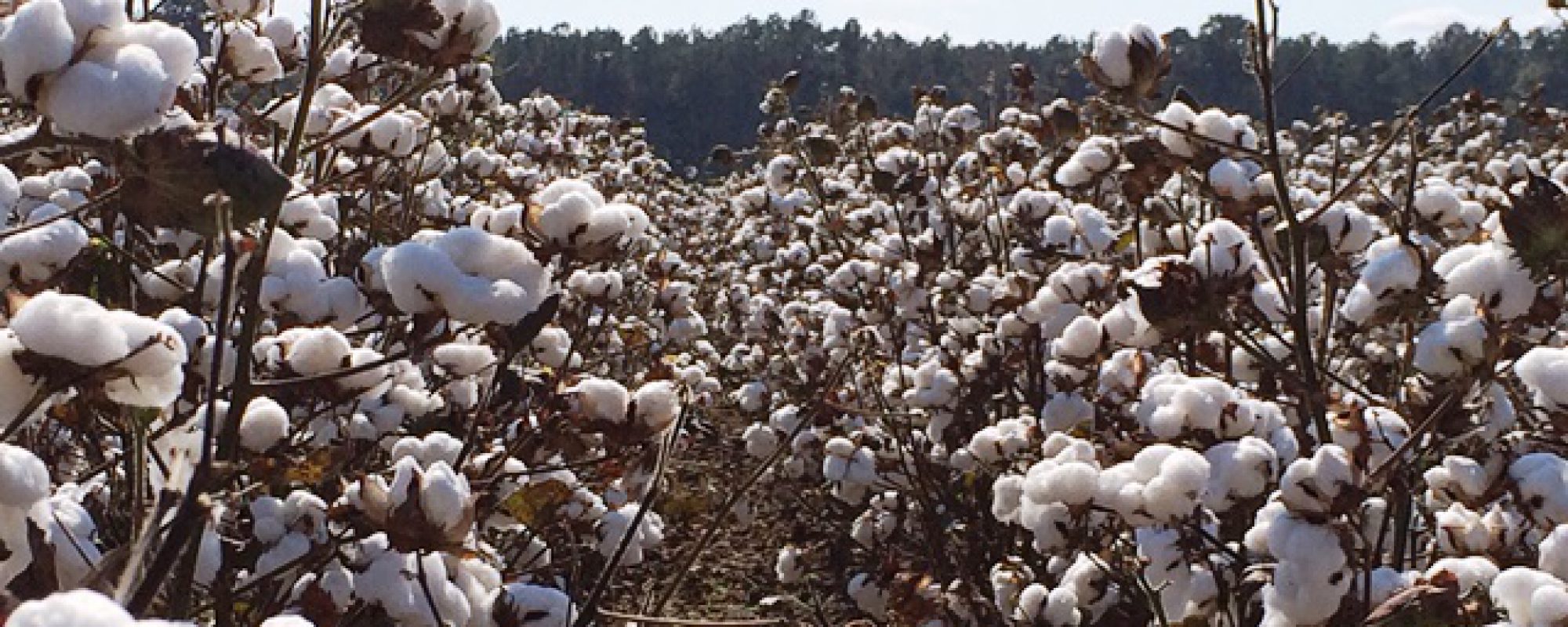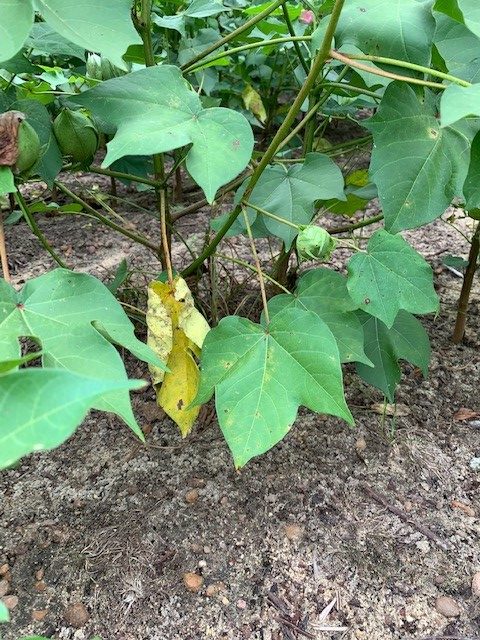Cotton
Three foliar diseases of cotton; target spot, areolate mildew, and bacterial blight have been found in Georgia. I saw some areolate mildew in cotton at 4th week of bloom yesterday in the Denmark area (Figure 1 & 2). The best management of areolate mildew and target spot is with judicious and timely fungicide applications. Cotton can be effected by target spot until the 6th week of bloom and until within four weeks of defoliation for areolate mildew. When defoliation from either disease reaches 25% or so – the chances of slowing them with a fungicide is slim.
Stinkbug Management (Phillip Roberts): Southern green and brown stink bugs are the two most common
stink bugs infesting Georgia cotton. Both have sucking mouthparts and damage cotton by feeding on the
seeds of developing cotton bolls. In addition to mechanical damage, feeding allows for the introduction of
boll rot pathogens. Internal symptoms of feeding on medium sized bolls are the most reliable indicator of
stink bug infestations. Internal damage is defined as warts or callous growths on the inner surface of the
boll wall and/or stained lint. This wart or callous growth is easily visible less than 48 hours after the stink
bug fed on the boll. As bolls mature and open, damage often appears as matted or tight locks with localized
discoloration that will not fluff. Severely damaged bolls may not open at all. Research also suggests that
in addition to yield loss, excessive stink bug damage can reduce fiber quality.
Scouting for stink bugs should be a priority as plants begin to set bolls. In addition to being observant for
stink bugs, scouts should assess stink bug damage by quantifying the percentage of bolls with internal
damage. Bolls approximately the diameter of a quarter should be examined. Bolls of this age are preferred
feeding sites for stink bugs can be easily squashed between your thumb and forefinger. It is important that
bolls of this size (soft) are selected. The number of bolls per plant which are susceptible to stink bugs is not
constant and varies during the year. The greatest number of susceptible bolls per plant generally occurs
during weeks 3-5 of bloom. During early bloom there are relatively few bolls present. During late bloom,
many bolls are present but only a limited number may be susceptible to stink bug damage (individual bolls
are susceptible to stink bugs in terms of yield loss until approximately 25 days of age). A dynamic threshold
which varies by the number of stink bug susceptible bolls present is recommended for determining when
insecticide applications should be applied for boll feeding bugs. The boll injury threshold for stink bugs
should be adjusted up or down based on the number of susceptible bolls present. Use a 10-15% boll injury
threshold during weeks 3-5 of bloom (numerous susceptible bolls present), 20% during weeks 2 and 6, and
30%(+) during weeks 7(+) of bloom (fewer susceptible bolls present). Environmental factors such as
drought and/or other plant stresses may cause susceptible boll distribution to vary when normal crop growth
and development is impacted; thresholds should be adjusted accordingly. Detection of 1 stink bug per 6
feet of row would also justify treatment.
When selecting insecticides for stink bug control it is important to consider other pest such as whiteflies,
corn earworm, aphids, or mites which may be present in the field. The objective is to control stink bugs but
also to minimize the risk of flaring other pest which are present. A couple of bullet points below to consider
when selecting a stink bug insecticide:
• Consider week of bloom and use the dynamic threshold.
• Determine ratio of southern green to brown stink bugs, organophosphates provide better control of
brown stink bugs compared with southern green.
• If whiteflies are present, use bifenthrin and avoid dicrotophos during weeks 2-5 of bloom.
• If corn earworm is present consider using a pyrethroid if brown stink bugs are low or using a
pyrethroid tank mixed with a low rate of an organophosphate if brown stink bugs are most
common.
• If aphids are present, include dicrotophos and avoid acephate if an organophosphate is needed. If
mites are present, avoid acephate if an organophosphate is needed
Peanuts
Make sure you are staying on schedule with your peanut fungicide program. Cloudy, wet weather following the recent hot and humid conditions is an excellent recipe for white mold and leaf spot to explode. I have seen some leaf spot within the peanut canopy, but nothing excessive as of yet. Be sure to stay on a good fungicide program, tightening spray intervals where disease is becoming problematic and/or where there is concern.
Peanut Insect Management (Mark Abney): I am continuing to see low numbers of tobacco budworm (TBW) caterpillars in my research plots, and I am still getting reports of some fields being sprayed for this pest. At this point in the season, it is important to use thresholds for making caterpillar treatment decisions. The threshold is an average of 4 to 8 caterpillars per row foot across 10 randomly selected locations in a field (sample 3 feet of row at each location). Use the lower end of the threshold when plants are small or stressed and the higher end of the threshold when the vines are rank and/or rapidly growing. Spraying caterpillars when populations are below threshold provides no value to the grower. Every peanut field in Georgia needs to be scouted, but every field does NOT need to be sprayed.
It is about time for velvet bean caterpillars and soybean loopers to show up across larger portions of our growing area. In what seems to be a favorable year for caterpillars, I have already heard reports of fall armyworm exceeding thresholds in peanut. The caterpillar thresholds given above are the same for all the foliage feeding species we encounter in peanut. We have good insecticide options for caterpillar management. Knowing the identity and relative abundance of the species present in a field can help determine which active ingredient to choose. UGA county Extension agents can help with insecticide decisions.
Three cornered alfalfa hoppers (TCAH) are present in peanut fields, and their numbers generally increase from mid to late summer. Though this insect is often present in very high numbers, it is not considered a major pest of peanut. Can TCAH cause yield loss? Yes, but the losses are typically minor, and managing the insect presents some challenges. First, the insect is highly mobile. Killing the adults in a field today will not matter much if more fly in at the end of the week. Second, the insecticides available to kill TCAH do not have long residual activity, and efficacy is not always that great. Add to all that the fact that these insecticides can flare spider mites in non-irrigated fields, and you can make a pretty good argument for leaving TCAH alone. There are situations where I think treatment for TCAH will pay, but I am generally not worried about this insect.
Soybeans
Soybean rust was identified in Midville last week. For those of you that have soybeans, it is advised to use a fungicide to protect against rust if they haven’t reached R6/full seed growth stage or have not already been sprayed within the last 21 days.


